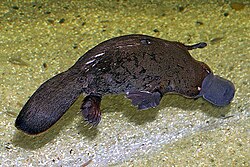Male Platypus Reproductive System
1.Testes 2.Epididymis 3.Bladder 4.Rectum 5.Ureter 6.Vas Deferens 7.Genito - Urinary Sinus 8.Penis enclosed in a fibrous sheath 9.Cloaca 10.Opening in the ventral wall of the cloaca for the penis.
The cloaca and the opening in the ventral wall of the cloaca are located on the surface of the platypus. All other components are found underneath the skin and tissue. The testes are the organs that produce the male spermatozoa. Behind the testes is the Epididymis, the duct that carries the spermatozoa to the vas deferens, which is the pathway for the sperm to travel from the testes to the urethra. The bladder stores the liquid waste of the platypus. The rectum is the pathway that secretes the solid waste. The genito-urinary sinus is the system that is concerned with creating and excreting urine. The cloaca is the cavity that releases excretory and genital products.Relevante Bilder
Relevante Artikel
KloakentiereDie Kloakentiere, früher auch Gabeltiere genannt, sind eine Ordnung der Säugetiere (Mammalia). Kloakentiere sind die einzigen Vertreter der Unterklasse der Ursäuger (Protheria). Der Name Kloakentiere weist darauf hin, dass Enddarm, Harn- und Geschlechtswege in einen gemeinsamen Ausführgang, die Kloake, münden. Sie unterscheiden sich von allen anderen Säugetieren dadurch, dass sie keinen lebenden Nachwuchs zur Welt bringen, sondern Eier legen. Dieses Taxon wird in zwei Familien unterteilt: die Ameisenigel (Tachyglossidae) und das Schnabeltier (Ornithorhynchidae) – insgesamt umfasst es fünf rezente Arten, die nur in Australien und Neuguinea leben. .. weiterlesen







